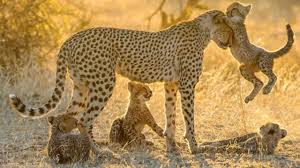23 Mar 2022 Cheetah Rehabilitation Action Plan in India

Cheetah Rehabilitation Action Plan in India – Today Current Affairs
- An action plan is being started by the Central Government to rehabilitate the ‘Cheetah’, which has become extinct in India after independence.
- In this regard, ‘Cheetah Rehabilitation Action Plan in India’ has been launched by the Union Minister of Environment, Forest and Climate Change under which 50 big cats will be brought to the country in the next five years.
- This action plan was launched in the 19th meeting of the National Tiger Conservation Authority (NTCA).
Today Current Affairs
What is ‘rehabilitation’ and the need to bring cheetahs back to the country?
- ‘Reintroduction’ of a species means the release of a species into an area where it is capable of surviving.
- ‘Rehabilitation of large carnivore species’ has been recognized as a strategy to conserve threatened species and restore ecosystems. Today Current Affairs.
- Cheetah, the only large carnivore, has been extinct mainly in India since historical times due to excessive hunting.
- India, at present, is financially able to consider restoring its lost natural heritage for ethical and ecological reasons.
Important facts: The Hindu Analysis
- Cheetah (Acinonyx jubatus – Acinonyx jubatus), is one of the oldest of the large cat species. Its ancestors can be traced back to the ‘Miocene era’, five million years ago.
- Cheetah is also the fastest terrestrial mammal in the world.
- It is listed as ‘Vulnerable’ in the IUCN Red Listed Species. Today Current Affairs.
- The ‘last spotted cat’ left in the country died in 1947 in Chhattisgarh. Later, the cheetah was declared extinct in India in the year 1952.
- The Asiatic cheetah is classified as a “critically endangered” species by the IUCN Red List, and is believed to be the only species left in Iran.
Cheetah Rehabilitation Program in India: The Hindu Analysis
- The ‘Cheetah Rehabilitation Project’ was prepared seven years ago by the Wildlife Institute of India in Dehradun with an outlay of Rs 260 crore.
- India has planned to resettle cheetahs in the extended ‘Kuno National Park’ in ‘Sheopur’ and ‘Morena’ districts of Gwalior-Chambal region of Madhya Pradesh.
- This is possibly the world’s first ‘intercontinental cheetah transfer project’.
Cause of Extinction: The Hindu Analysis
- The source of all causes of extinction can be traced to human intervention. Problems such as human-wildlife conflict, habitat loss and lack of animals to hunt as food, and illegal trafficking have led to the extinction of cheetahs.
- Climate change and increasing human population have made these problems worse.
- With a decrease in land available for wildlife, species that require greater territorial range, such as cheetahs, have to compete with other animals and humans and conflict over space.
Supreme Court’s decision: The Hindu Analysis
- The Supreme Court, in its 2013 order, quashed plans to settle African cheetahs in India and specifically in the Kuno National Park in Madhya Pradesh.
- The ‘Kuno National Park’ of Madhya Pradesh has already been identified as a habitat for leopards and tigers, and as per the Supreme Court order, this site has also been earmarked for the relocation of Asiatic lions. Therefore, African cheetahs are not needed to play the role of apex predator in these habitats.
- Last year (2021), the Supreme Court lifted a seven-year-long moratorium on a proposal to introduce African cheetahs from Namibia into Indian habitats.


No Comments